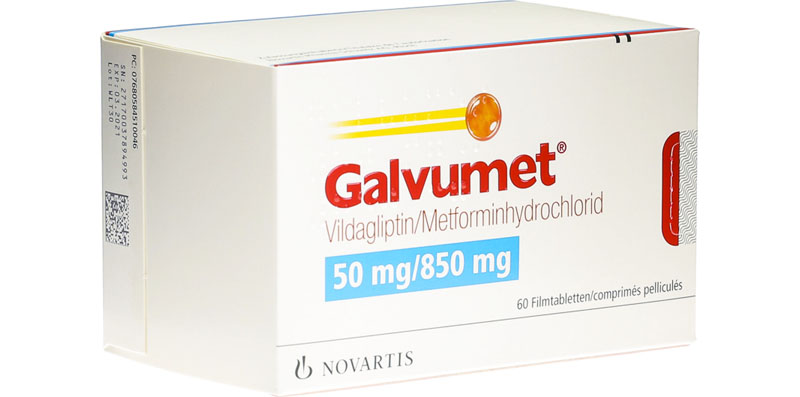What Is Galvumet
Galvumet is an antidiabetic pharmaceutical drug that is a combination of two active substances – vildagliptin and metformin. The product is designed for the treatment of type II diabetes through a biochemical mechanism for controlling blood glucose levels. Due to the use of two different molecules at once, the drug has a pronounced therapeutic effect and can be prescribed as a replacement for the combined therapy of vildagliptin and metformin.

Composition and Active Ingredients
Galvumet contains 2 components. Vildagliptin belongs to the class of islet enhancers. Metformin belongs to the class of biguanides.
The mechanism of action of Galvumet is to stimulate the pancreas to release insulin and reduce the production of glucagon due to vildagliptin. Metformin, which is part of the drug, helps the patient’s body use its own insulin.
The drug in a combination of two active substances has a pronounced therapeutic effect and is officially used in New Zealand in pill form.

Use Cases
Galvumet is a drug for type 2 diabetes. The drug is prescribed to diabetics who either previously took vildagliptin and metformin separately, or did not receive the proper therapeutic effect from the combination of metformin and sulfonylurea.
Galvumet can be prescribed as an additional drug to patients taking insulin. The combination of vildagliptin and metformin is used if insulin + metformin does not give proper control of blood glucose levels. The drug is prescribed by a certified doctor in combination with diet and physical activity.
Do I Need A Prescription?
Galvumet is a prescription drug that is prescribed by a doctor for patients with type 2 diabetes. At the same time, Galvumet cannot replace insulin and cannot be used in the treatment of type 1 diabetes or diabetic ketoacidosis. It is also important that there is no evidence base that confirms the safety of the drug for patients under 18 years of age. Taking the drug should also be carried out under the supervision of your doctor.
Vildagliptin and Metformin Dosing and Warnings
When taking Galvumet, a patient should carefully follow all the instructions of his attending physician and take into account all warnings about taking the drug published in the instructions. Despite the proven safety of the drug for adults, violation of the intake regime can lead to serious consequences.
Table 1
Galvumet
Dose adjustments in patients with renal impairment
| GFR mL/min | Metformin | Vildagliptin |
| 60-89 | Maximum daily dose is 3000mg*. Dose reduction may be considered if renal function declines. | Maximal daily dose is 1000 mg. |
| 45-59 | Starting dose should not be more than 1000 mg with a maximum daily dose of 2000 mg*. | Maximal daily dose is 1000 mg. |
| 30-44 | Starting dose should not be more than 500 mg with a maximum daily dose of 1000 mg*. | |
| ˂30 | Galvumet is contraindicated. |
*If metformin doses higher than those achievable with Galvumet alone, they are considered necessary.
How and When to Take
Galvumet pills are taken orally during or after meals. The drug should be taken at the same time for maximum effect and to control the regularity of taking the drug. The period of taking the drug should be determined by the physician. Unauthorized termination of the Galvumet course is unacceptable.
The standard dose of Galvumet is 1 pill 2 times a day. Taking more than 2 pills a day is undesirable. At the same time, the patient should fully comply with the doctor’s instructions.
The patient’s blood glucose level should be under the full control of the attending physician, who, based on the blood tests, can adjust the dose of Galvumet for a particular person. Patients with renal insufficiency or patients taking sulfonylurea together with Galvumet may be prescribed a lower dose of the drug.
In Case You Forget to Take It
The patient may forget to take Galvumet at the right time for one reason or another. If you missed a dose, but it’s time to take a new dose, do not take a double dose in any case. Just skip the previous dose of the drug, and then proceed according to the standard schedule. Otherwise, there is a high probability of a side effect. If you are 1-2 hours late, you can safely take the standard dose of the drug.
What to Do in Case of Overdose
If you have taken more of the drug than prescribed by your doctor and the current instructions for use, then you may have an overdose, as a result of which the following symptoms may appear:
- swelling in the arms or legs;
- tingling or numbness in the hands or feet;
- muscle pain;
- high temperature;
- feeling of cold in the hands and feet;
- feeling weak and exhausted;
- feeling slightly dizzy;
- severe nausea or vomiting;
- general feeling of discomfort;
- muscle pain;
- fatigue;
- abdominal pain;
- weight loss;
- arrhythmia;
- rapid or labored breathing.
In case of overdose, you should consult a doctor or the nearest hospital. Even if you do not record the symptoms of an overdose, you still need to contact a doctor. It is also recommended to inform the patient’s relatives about the symptoms of overdose so that they can call a doctor in a timely manner if a critical situation occurs.
Precautions
Despite the fact that Galvumet is officially registered in New Zealand, which confirms its safety for patients in the treatment of type 2 diabetes, there are a number of precautions that both the patient and the attending doctor need to pay attention to. They are presented below.
Allergy Warnings
Galvumet should not be used in the treatment of patients with an identified allergy to the active ingredients of the drug – vildagliptin or metformin. The same applies to the other components of the drug, as well as to drugs of a similar class or structure.
An allergic reaction to one or more components of Galvumet may manifest as:
- shortness of breath;
- wheezing;
- difficulty breathing;
- swelling of the face, lips, or other parts of the body;
- rash, itching, hives.
Carefully monitor these conditions and be sure to inform your doctor about them in case of allergy to the components of the drug. Despite the fact that allergies to the components of the drug are not so common, the reaction can be very serious up to a fatal outcome. Therefore, all allergic manifestations of the body should be reported to the doctor in advance.
Health Conditions Warnings
There are a number of pathological conditions when taking Galvumet is unacceptable. They include:
- reduced kidney function, when taking the drug, according to the attending physician, may harm the body;
- liver problems that make taking the drug unsafe for the patient;
- a recent heart attack;
- heart failure;
- circulatory problems;
- serious complications due to diabetes (diabetic ketoacidosis or diabetic coma).
It is not allowed to take Galvumet before and immediately after an X-ray with contrast.
Vildagliptin and Metformin Side Effects
Table 2
Galvumet
Adverse reactions reported in patients who received vildagliptin 50 mg twice daily in combination with metformin and sulfonylurea
|
Nervous system disorders Common |
Dizziness, tremor |
|
General disorders and administration site condition Common |
Asthenia |
|
Metabolism and nutritional disorders Common |
Hypoglycaemia |
|
Skin and subcutaneus tissue disorders Common |
Hyperhidrosis |
Galvumet has a wide range of side effects, which in rare cases may occur in individual patients. The main ones:
- redness of the skin or itching;
- peeling of the skin or blistering;
- joint pain;
- swelling of the arms, ankles or feet;
- low blood glucose;
- diarrhea;
- abdominal pain;
- burning sensation in the chest;
- heartburn
- metallic taste;
- loss of appetite;
- constipation;
- flatulence;
- weight gain.
If one or more of the above symptoms are detected, the patient should contact their doctor and report the problem. It is also worth remembering that an allergic reaction may occur after taking the drug. In turn, nausea, excessive sweating, weakness, dizziness, trembling, headache or chills may be a sign of hypoglycemia. This condition can occur with insufficient food or after significant physical exertion. However, alcohol abuse can also cause similar reactions.
In rare cases, metformin can cause lactic acidosis. In this situation, the patient needs to see a doctor promptly, since the loss of control over this condition can lead to death. In general, if you feel unwell, you should immediately consult a doctor, since a number of rare side effects that occur when taking the drug are not listed.
Interaction with Other Medicines
When prescribing the drug, the doctor must necessarily find out whether the patient is taking any other pharmaceutical products, including over-the-counter drugs. There are a number of substances that are undesirable to take together with the active components of the drug. It is likely that the doctor will have to adjust the dose of the drugs or develop an individual intake scheme if we are talking about a patient taking such drugs. First of all, you need to pay attention to the cross-reception of the following groups of drugs:
- anti-infective drugs (vancomycin, trimethoprim);
- corticosteroids;
- drugs for the treatment of hypertension (amiloride, triamterene, nifedipine, enalapril, losartan, diuretics);
- drugs for the treatment of arrhythmia (digoxin, quinidine);
- drugs for pain relief (morphine, diclofenac);
- drugs for the treatment of gastric disorders (cimetidine, ranitidine);
- drugs for the treatment of mental disorders (phenothiazine);
- drugs for the treatment of thyroid pathologies;
- oral contraceptives and some drugs to reduce the symptoms of menopause or osteoporosis.
Also, if it is necessary to inject an iodine-containing contrast agent, Galvumet should be temporarily discontinued. Remember that only the attending physician decides whether to resume therapy.
After Using Galvumet Medication
The manufacturer of the drug has developed simple rules for the safe handling of Galvumet, which are presented below.
Storage
It is recommended to store the drug in its original packaging in a dry place inaccessible to children at a temperature of at least 30 degrees. Moisture should be avoided on the packaging. Do not leave the drug in direct sunlight. Do not take the expired drug (indicated on the package).
Disposal
If your course of taking Galvusmet has been completed, and you still have unused pills, then consult your pharmacist regarding their disposal. The same applies to pills which expiration date has expired.
Galvumet Tablet Alternatives
At the moment, Galvumet is not available in all countries. If there is no such pharmaceutical product in your country, your doctor may prescribe a similar generic. In particular, a drug with the name Galvus-Met of the same composition and pharmacological group as Galvumet is available in a number of countries. Or it may be 2 different medications Galvus (Vidagliptin) and Glucophage (Metformin).
At the same time, the appointment of alternative antidiabetic drugs should be made by a qualified medical specialist. You mustn’t replace one drug with another on your own. Follow your doctor’s instructions.



































